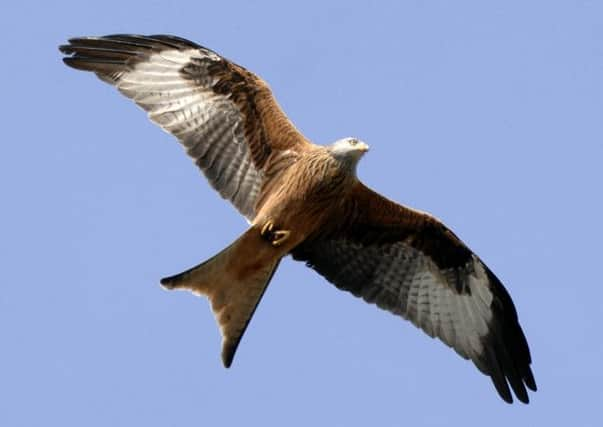Highland bird boost as red kites spotted at Cawdor


They are the first pair to attempt breeding in Nairnshire for over 150 years.
The raptors setting up home away from the scene of poisonings has left the RSPB overjoyed, while the Dowager Countess of Cawdor has expressed her own delight at their appearance.
Advertisement
Hide AdAdvertisement
Hide AdLady Cawdor said: “As the guardian of this historic woodland I am thrilled at the return of the red kites, these birds are in a sense part of the history of this area.
“At Cawdor we do our best to promote and nurture the environment, our gardens have been organic since 1979 and we are keen to promote nature conservation wherever possible.”
The birds have built a nest in woodland immediately adjacent to the castle and are often seen from the castle flying to and from the nest.
RSPB conservation officer Stewart Blair confirmed the historic nature of the breeding attempt.
He said: “Records indicate that kites have not bred in Nairnshire since the early 1800s.
“Cawdor Castle has been the scene of many historic events over the centuries so it seems very appropriate that the grounds of the castle have been chosen by the kites.
“Red kites would, undoubtedly, have been a familiar sight to William the 3rd Thane of Cawdor, who built the Castle in around 1370. It’s very rewarding to think that part of Nature’s historic fabric is slowly being restored.”
Mr Blair said their arrival provided some “good news” for the species after the “awful events” in the Black Isle when 16 kites – along with six buzzards – have been found dead.
Advertisement
Hide AdAdvertisement
Hide AdHe added: “Let’s hope the kites now go from strength to strength in Nairnshire and bring delight to even more people.”
One of the red kites at Cawdor was satellite-tagged as a nestling in the Black Isle and its movements have been tracked by RSPB staff since it fledged.
Raptor poisonings
Police are continuing their investigation in the deaths of raptors in Ross-shire.
Of the 22 discovered in a two square mile area near Conon Bridge since March, tests have so far confirmed that 12 of the birds were poisoned.
A reward of over £20,000 for information leading to a prosecution has been added to by donations from RSPB Scotland, landowners, farmers and the public.
After the initial discovery of six dead birds, RSPB Scotland offered a £5,000 reward for information which would lead to a successful conviction.
Further discoveries prompted an anonymous donor to come forward with an additional £5,000, while almost 200 members of the public have made further donations of over £4,000.
Members from of Scottish Land and Estates and the National Farmers Union (NFU) Scotland, who have condemned the killings – branded the most serious wildlife crime in recent years – offered an additional £12,000 to an appeal for information.
Advertisement
Hide AdAdvertisement
Hide AdHistoric Cawdor Castle, now a five-star tourist attraction, has links with MacBeth.
It has been the ancestral seat of the Thanes of Cawdor since the late 14th century and the real Macbeth was Thane of Cawdor and became King of Scotland after the death of Duncan in the 11th century.
In the Shakespeare play, written in 1606, the murder of Duncan takes place in Inverness Castle.
Many academics have associated the killing with Cawdor Castle.
However, that theory has been discounted by others because the building was not constructed until the late 14th century.
The location has been the scene of a number of internal family battles in recent years, with numerous court actions over property between the Dowager and her step-son, Colin Robert Vaughan Campbell, the 7th Earl of Cawdor and the 25th Thane of Cawdor.